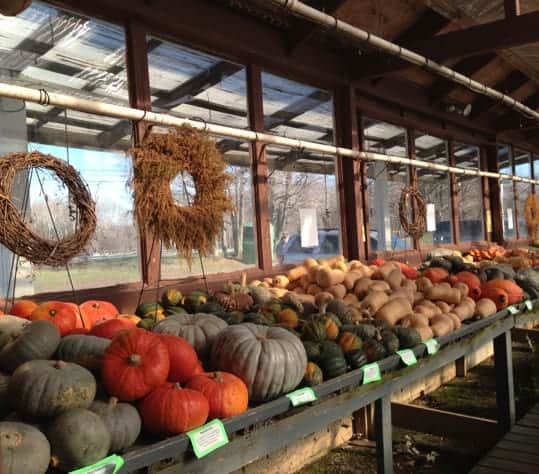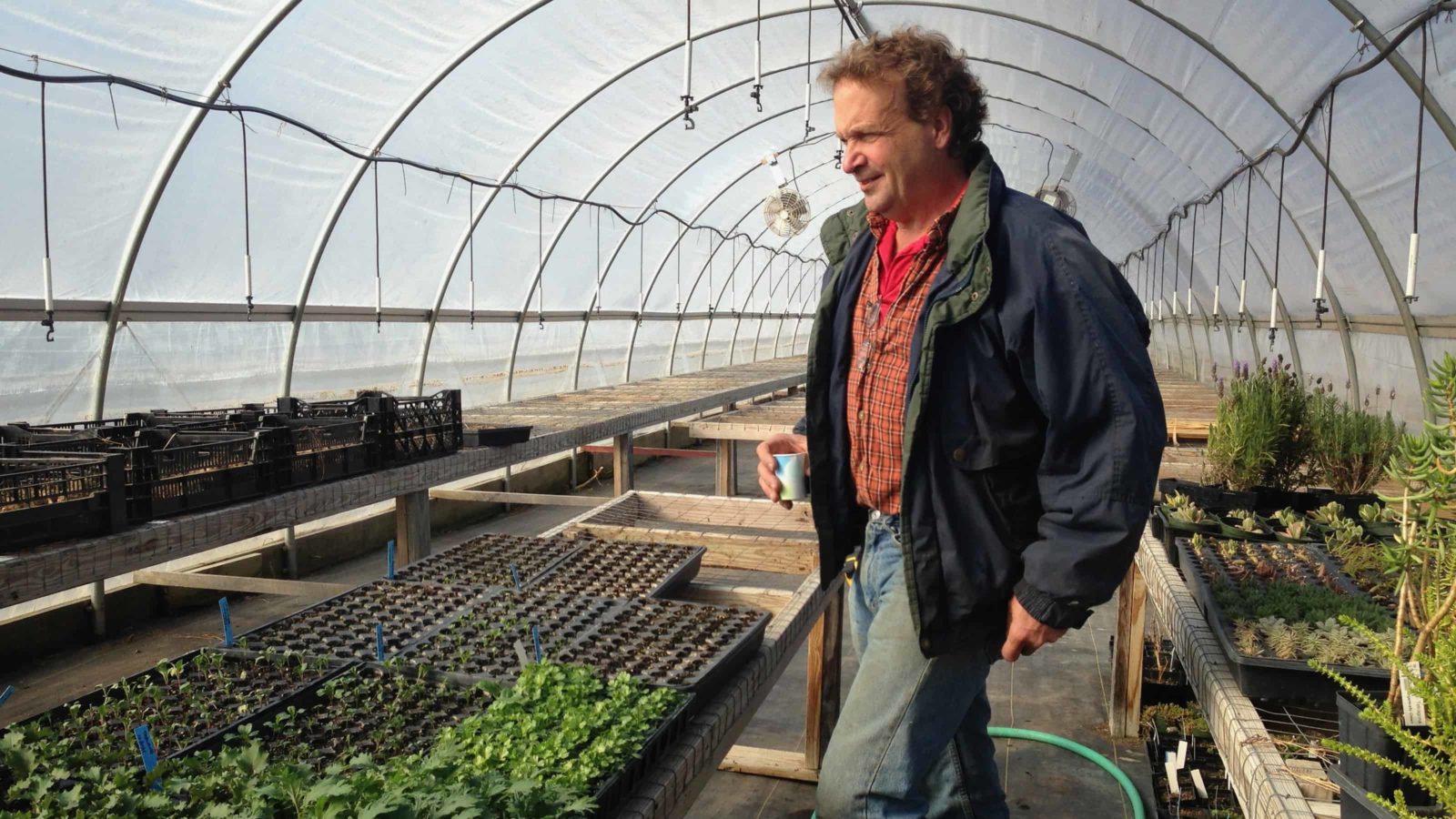They have made wreathes with herbs, dried flowers, corn tassels, wheat, broom corn leaves, juniper, boxwood … some traditional decorations and some wild ones. Chatham Berry Farm store in Chatham, N.Y., has opened its annual holiday market with natural ornaments and Douglas, balsam and Frasier fir trees from New York and Vermont, and beeswax candles from a beekeeper who keeps hives on the farm.
People will stop in on the way home, said farmer Joe Gilbert. He keeps his farm store open year-round, stocking it with greens form his greenhouses, local eggs and cheese and honey, vegetables and fruit, soup and sauces made at the store, and ingredients to go with them — fresh and frozen meats, pickles and relishes.
“It bothers me,” he said, “the idea that if you can afford it, you can eat healthy. My prices are for everyone. I feel that strongly.”

Squashes and wreathes sit on display at the Chatham Berry Farm Store.
Gilbert started in 1982 with a summer fruit stand, bringing berries to greenmarkets in New York. But he felt that all the good locally grown food was getting shipped to the city, and it frustrated him.
“When you came here, at the local supermarket, a Finast, you were lucky to get a wilted Red Leaf lettuce,” he said, “and you were rejoicing because it wasn’t Ice Berg.”
In those early days he added slowly vegetables and greens to his farm stand. One summer a neighbor heading out on vacation gave him a few armfuls of arugula from her garden, he said. An hour later, a man stopped by and bought all 12 bags. The “arugula guy” became a regular customer.
Gilbert began to carry potatoes, local peaches, apples from a friend. Over time he expanded his own fruits and vegetables, including many kinds of berries — pick-your-own strawberries, blueberries, blackberries, black raspberries, gooseberries, currants … and 100 kinds of tomatoes in summer and fall.
Early on he was raising three children, and he hired local young men and women to work on the farm.
“There’s not much to do around here” for teenagers, he said, “and there are no agricultural programs in the schools — how do kids know they might be interested in farming if it’s not presented? We don’t cultivate this now.”
He and his team diversified and found ways to ride tough years, he said — in one year he and his crew painted houses when an unseasonable freeze hit the berry crop.
“I work a lot,” he said. “Some of it I don’t consider work. When the kids were in school I never missed a football game or a volley ball match or a dance recital, or a dance practice for that matter. … I like what I’m doing, so most of the time it’s not really work. What else is there — football games? Last Sunday I sat down with a glass of iced tea for a few minutes and said ‘ok, let’s fix that roof.’ I’m not a good sitter.”
With his energy, Chatham Berry Farm has grown in all directions. The building has expanded until the only part of the old farm stand left is the original counter, and the farm, shop and greenhouses have grown with it.
In mid-November the Gilberts were picking the last of this year’s tomatoes, and they will have greens all winter from sunken and hydroponic greenhouses.
Gilbert’s older son, Jonathan, has driven the move toward hydroponics. Joe never made his children work at the farm growing up, he said, and now two of this three children have come back to join him in the business. Gilbert’s younger son, Michael, has brought his knowledge of solar energy into the business, generating power and and warm water, and Jonathan has led the building of the farm’s first hydroponic greenhouse. The youngest, his daughter Lilian, is studying veterinary science at Delaware Valley University.
Jonathan runs the greenhouses now, Gilbert said. Michael is learning the meat cutting operation, sales and computer tech at the store. And Jonathan’s partner, Alexia Baker, has worked at the store for three years and runs the herb house.
Joe Gilbert does the plumbing and electrical work himself. He has built his own shelves and installed windows with panes of thick, wavy glass that came from a public school in the Bronx torn down 100 years ago. They let light into an enclosed outer area with long tables to hold bedding plants in the spring, squashes and pumpkins in the fall and wreathes and Christmas trees in December.
Early in the winter the Gilberts will begin to raise seedlings for the spring, Joe said. Their herb house grows more than 120 kinds of herbs into mid-summer, and they are constantly changing and planning ahead.
“For the store to be interesting to you as a buyer, it has to be interesting to me,” he said.
He walked around the greenhouses, showing the older ones sunk into the ground to keep cool in the summer and warm in the winter. Not long ago all greenhouses were partially buried like this, he said.
The plants sit on raised benches, and underneath pipes carry warm water to warm the soil. The Gilberts heat the air only slightly, he said. As long as the roots are warm enough, the plants will survive in temperatures above freezing. He used to heat the soil by heating the air, and it took much more effort and energy, because heat rises.
Now they are building a second hydroponic greenhouse and adding to the row of sunken greenhouses. In one Gilbert hopes to grow Southern varieties of blackberries and raspberries. One 100-foot row of these cold-sensitive Southern varieties can produce more than two or three acres of Northern berries, he said. And with the hydroponic greenhouses he hopes to have strawberries through the winter — strawberries like the cold.
Now the first hydroponic greenhouse holds rows of winter greens. He pulls off a leaf of arugula, crisp and green with a fresh bite to it.
“People should know where food comes from,” he said. “We’re open, and there are no secrets.”
Here a 1,000-gallon tank holds water and organic fertilizer, he explained, and the water circulates carrying all the nutrients usually found in the soil. They re-use the water and monitor carefully — a computer analyzes the water and adds more calcium or magnesium as needed and raises and lowers curtains to let in light
“It took three greenhouses to produce what this one produces now,” Gilbert said.
Energy and sustainability both seem to run in the family. Joe Gilbert’s father used to illustrate energy efficient homes for Rodale Press organic gardening magazine, he said.
It takes sustained energy to keep the farm running smoothly. Gilbert remembered the day Hurricane Irene came through. The stream nearby rose, flowed around its earth berm bank and over the road. The water rose above a 10-foot deer fence, he said. He had water a foot above the garden benches — and three feet of water in the store.
Gilbert shut off the power at the store, and as he walked through his own front door the power at his house went off.
He came down to the shop to collect his generator and carted it through four feet of standing water and uphill to his house — and went back for the extension cord — and two hours later, as he got the generator started and sloshed in soaked to the skin, the lights came on in his neighbor’s house. So he brought the generator back to the store to run the pump and began pumping water back over the earth berm. The crew came in to clean as he disassembled and re-started equipment. And the shop re-opened, scrubbed and dry, the next day by lunchtime.



